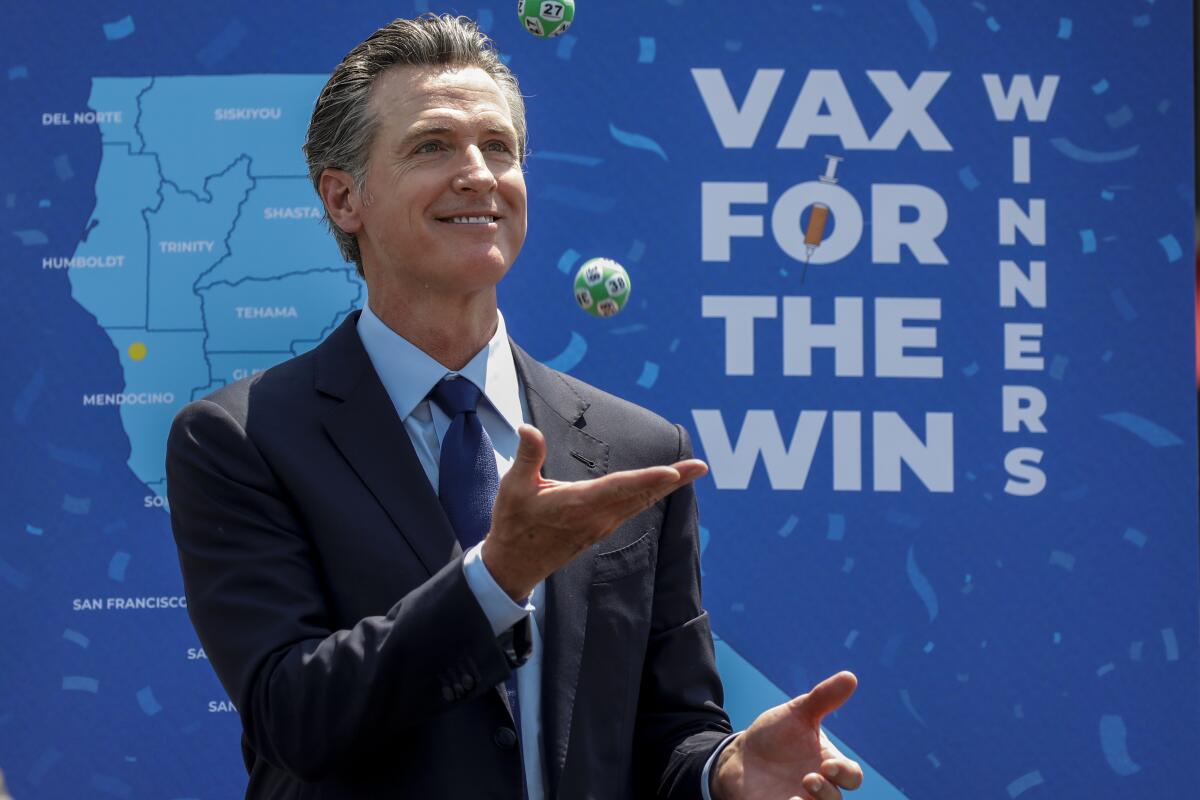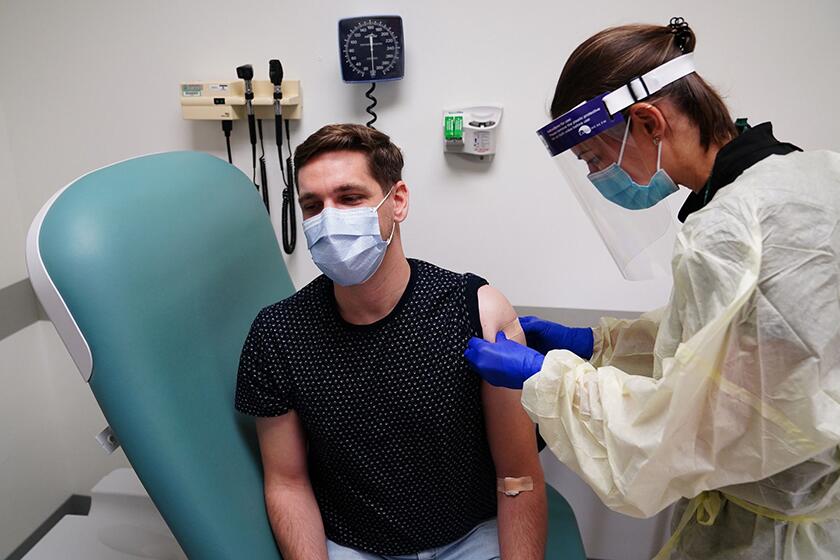Why California’s reopening isn’t destined to fail this time

- Share via
Good morning. I’m Paul Thornton, and it is Saturday, June 19, 2021. Today is Juneteenth, which commemorates the emancipation of Black slaves in America; this year’s celebration is the first to be officially observed by the federal government.
Let’s take a look back at the week in Opinion.
By typical standards, we’re off to a miserable start to summer in California. The already parched western U.S. is on the tail end of a punishing heat wave, bringing not only August-like temperatures but, in Los Angeles anyway, the climatic plague known as “humidity.” Wildfires are burning in the San Jacinto Mountains and Big Sur, and reservoirs are resembling puddles at precisely the time of year they should be brimming with runoff from mountain snow.
Did I mention it’s not even summer yet? (Happy last day of spring, by the way.)
Despite the fact that the comfort of a California summer is wholly dependent on the hydrological cycle, there is a feeling of profound relief among us, even if it seems that every parched leaf and shrub in the state is primed to burn. The Times Editorial Board notes that we’ve been here before — just last spring, in fact, when Gov. Gavin Newsom abruptly and ill-advisedly lifted the restrictions credited with sparing California the pandemic devastation seen in New York. We know things now that we didn’t know then — for example, how easily asymptomatic people in poorly ventilated indoor spaces could spread the coronavirus to multiple people at once. We also lacked the most important weapon in the battle against the pandemic: highly effective, widespread vaccination.
I’d also suggest a less tangible advantage today: a cautious collective mindset, one shaped by how quickly we all witnessed COVID-19 spiral completely out of control last fall and turn parts of California, most notably Los Angeles County, into pandemic hot spots.
Around the time California first lifted its restrictions last spring, Newsom was widely praised for averting a disaster, and The Times was running op-ed articles like the one crediting Los Angeles’ urban sprawl for sparing us the devastation seen in dense New York City. Things are different now. California enters the post-June 15 reopening phase just as traumatized as New York or any other place forced to reckon with its hubris.
That may not be as protective as a vaccine, but it can only help us right now.
Don’t throw away that mask just yet. Fully vaccinated Californians are no longer required to wear a face covering in most settings. Still, many people who have endured more than a year of mandates, surges and warnings may not be eager to expose their noses and mouths, especially with unvaccinated Californians left to police themselves on the masking rules that still apply to them. Cautious people will continue to wear masks — and that’s OK. L.A. Times
There are some vestiges of pre-pandemic life that should not come back. In May 2020, we asked readers to send us their thoughts on what California ought to look like after the pandemic. That was when the state was in a budget crisis, George Floyd was alive, and we appeared to have avoided a major surge in coronavirus cases and deaths. More than a year later, we asked some of the readers who wrote to us then to update their responses; what they said touched on racial justice, healthcare access, environmental quality, housing and other issues that, as the pandemic demonstrated, need society’s urgent attention. Other readers reacted to The Times Editorial Board series on creating a more equitable and sustainable state after COVID-19.
California has a connection to Juneteenth, and you probably didn’t learn about it in school. The annual June 19 commemoration is celebrated almost exclusively as marking the freedom of Black people in the South. Historian Susan D. Anderson points out that California’s admission into the union as a “free state” in 1850 was part of a compromise that resulted in the Fugitive Slave Act being “devastatingly overhauled” and that the state passed its own such law in 1852. In many ways, California in its early days was a “society with slaves.” L.A. Times
Enjoying this newsletter? Consider subscribing to the Los Angeles Times
Your support helps us deliver the news that matters most. Become a subscriber.
The ACLU should stick to uncompromisingly defending freedom of speech. The American Civil Liberties Union is at an inflection point, with younger attorneys and staff prioritizing more overtly progressive causes such as LGBTQ and immigrant rights and many longtime, legacy supporters dismayed by the organization’s equivocation on protecting the free-speech rights of vile groups such as neo-Nazis and white supremacists. “The ACLU does lots of great work, including fighting for immigrants and LGBTQ people and racial justice,” writes op-ed columnist Nicholas Goldberg. “But its commitment to the 1st Amendment has always been its core mission.” L.A. Times
She’s watched the Republican Party’s radicalization over decades. Now, The Times’ White House editor, Jackie Calmes, has this warning about where today’s Trump-aligned GOP appears headed: “Should Trump remain exiled at Mar-a-Lago, his MAGA army will soldier on, forcing party officials and 2024 presidential aspirants to fall in line. And if Republicans lose in 2022 or 2024, many seem poised to reject the result, turn to force or countenance those who do — Trump or no Trump.” L.A. Times
Stay in touch.
If you’ve made it this far, you’re the kind of reader who’d benefit from subscribing to our other newsletters and to the Times.
As always, you can share your feedback by emailing me at paul.thornton@latimes.com.
A cure for the common opinion
Get thought-provoking perspectives with our weekly newsletter.
You may occasionally receive promotional content from the Los Angeles Times.







